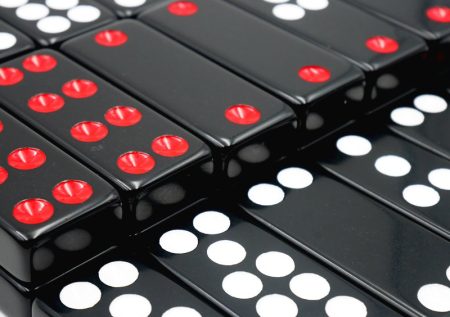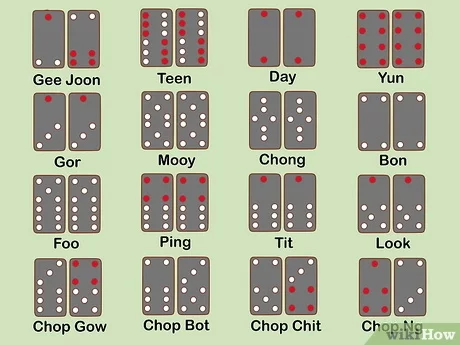


Pai Gow is a traditional Chinese domino game with multiple variations and exciting gameplay. In online casinos/gaming venues/cash cities, the most common Pai Gow game is “Banker Pai Gow.” The following series provides a detailed explanation of Pai Gow gameplay, rules, and even includes tips for winning strategies! It allows you to explore a new world in online casinos and win more money!
The winner is determined by comparing the different combinations of two dominoes. The game uses a set of 32 cards, and each round consists of two sets of comparisons. Players must complete both sets to exit the game or rematch. At the start of the game, players can compete for the role of banker. The player with the highest “banker bet” becomes the banker for that round. If players have the same banker bet, the player with more game coins will sit in the banker position. If no player competes for banker, the system will randomly select one player to be the banker. After the banker position is determined, players start placing bets. The player can choose the “bet multiplier,” and the more game coins they have, the higher the multiplier they can bet. If a player fails to bet within the designated time, the system will automatically place the minimum bet for them. Once betting is completed, the system rolls the dice to determine the dealing order. Each player receives two cards per round and compares them. Only the player can compare their cards with the banker.
Pai Gow Tiles Wenzis Wuzis Single tile size sequence Nine tile size sequence Pai Gow heads Titles that indicate the dealing method. Generally, after shuffling, players will arrange the tiles into eight rows, folded into four rows. The banker will roll the dice. Before rolling the dice, players must declare how they want to deal with the tiles, i.e., how to take the tiles. Common Pai Gow heads include: Left and right: Each player takes two mounds in alternating fashion (four tiles per mound). Interval mounds: The first player takes mounds 1 and 3; the second player takes mounds 2 and 4; the third player takes mounds 5 and 7; the fourth player takes mounds 6 and 8. Each player takes one mound (two rounds total). Middle dig/dig the middle: The first player takes the middle two mounds (eight tiles), while the two players on either side take one tile each from the center. Double-wing flight: Player 4 and 5 take the 4th and 5th mounds, starting 1 and 8 tiles. Cutting ears: The opposite of double-wing flight. The first player takes one mound from each side (eight tiles), and each side takes one tile. Top bottom/peeling: Each player takes the top eight tiles. Dragon head Phoenix tail: Takes the two mounds at the end. Three-lion dance: Player 6, 7, and 8 take the 6th, 7th, and 8th mounds respectively, starting 1, 3, and 5 tiles. Depending on the dice result, the player who rolls the dice gets the first tiles, followed by other players.
Other tile heads include: Small-medium-stack, medium-stack, bottom-out medium-stack, medium-stack transforms into medium-stack, flying on both sides of the medium-stack Middle-horizontal sixteen, cut two, cut two in the middle, cutting each mound, double ghost knocking on the door, heavenly net, heavenly one dipping into the earth one, Han Xin counting soldiers…

The following are some Hong Kong terminologies for “calling tiles” and “discarding tiles”: “Seven-seven-eight-eight, don’t want nine; come nine-nine, smash hand” – Refers to getting the highest combination of tiles called “Heaven, Earth, Tiger Head.” “Heaven, Earth, Tiger Head hug” – Refers to getting “6, 7, 8,” which can form a straight combination. “Ding San Pei Er Si – Absolute best match” – Refers to getting the “Big Monkey” pair, which is the best combination in Pai Gow called the “Supreme Treasure.” “Five-six don’t want seven; two-four ascends to the throne” – Describes having a “Small Monkey” tile with three points, and adding seven points will result in a combination called “Suppressing Ten.” In this case, “two-four” refers to the “Big Monkey” representing six points, and the “Monkey Pair” is the best combination in Pai Gow called “Ascending the Throne.” “Seven-eight loses to nine; heaven and earth draw hands” “Pair down to a turtle-ten, Emperor no poor people” – Describes someone touching a tile that might be followed by a “Turtle Ten,” indicating that the next tile will be missing. “Common things after a pair” – Describes a player touching a pair of tiles, indicating that the next one might be a “Long Three.” “Poor dice, rich discard” – Describes a player being careless and dropping the dice on the floor, which results in a loss; however, if the tiles drop, the player will win. ” ” – Describes a player having tiles with 4 and 5 points.

Similar to Mahjong, playing “Heaven Nine” and “Mahjong,” Pai Gow is a game that emphasizes analytical thinking, memory, personal luck, and capturing opponents’ psychology. The gameplay and rules are similar to Mahjong and Bridge, using the same tiles, but the gameplay is entirely different. Pai Gow tips, winning strategies Don’t rush to be the banker or sit in the banker position. Players should observe the situation around the table first. In general, there will always be one or two unlucky players per round of Pai Gow in Hong Kong. Once you identify them, you will recognize their betting pattern, making them a landmark for online casinos/gaming venues/cash cities. Card memory Hong Kong players not only need to remember the high-ranking tiles like “Heaven Tiles,” but also the 16 tiles left on the table after the first deal. By combining other players’ tiles and guessing the banker’s hand, the probability of winning will be higher. Be attentive as the banker When sitting as the banker, remember to observe all sides and listen carefully. After receiving the tiles, avoid moving them immediately and observe the other players to prevent tile manipulation by others. Guess the quality of their tiles based on their expressions. “High tiles” and “low tiles” After receiving four tiles, players must divide them into two hands, each with two tiles. The larger hand is called “high tiles” or “back tiles,” and the smaller hand is called “low tiles” or “front tiles.” Combining high and low tiles determines the highest value hand, and in Pai Gow, the higher the low tiles, the stronger the hand, increasing the chances of winning.